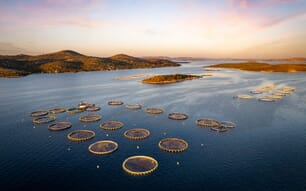The oceans cover 70 per cent of the world’s surface, but only produce two per cent of the world’s food Solveig van Nes from the environmental and climate change campaigning group, Bellona, told a Norwegian inspired conference in London “How Can Green Solutions be Good for Business”.
Dr van Nes said that producing food in the oceans was one way forward to produce more with fewer resources and by creating a smaller environmental impact.
However, Dr van Nes added that the way forward was not to increase fishing catches, as many fish stocks were already being fished to their limit, but to adopt systems of sustainable aquaculture.
At present much of the global fish farming sector is based on monoculture farming, harvesting one species of fish that needs feed that itself need to be produced.
Dr van Nes said that the sector needs to look at multi-culture farming using other species alongside traditional fish such as salmon, such as algae and mussels.
She said that the algae and mussels alongside fish farms capture the nutrients and the CO2 emissions and the phosphorous and the mussels feed on the waste food and faeces of the fish enhancing the environment.
“You can produce a lot more biomass and produce more without increasing the use of resources,” said Dr van Nes.
She said multiculture systems reduce the nutrient load and increase resource efficiency using local renewable resources.
She added that these systems also help to increase profitability and green jobs.
While the fish produced are a major source of protein together with the mussels, the algae can be used to produce biofuels, food and feed, medicines and supplements and fertilisers.
She said that the greenhouse gases that are captured by the algae and mussels are only released again when there are used as fuels or as fertilisers.
Without using multitrophic seafood production systems that capture carbon and produce biofuels, Dr van Nes said the increase in greenhouse gas production would be dramatic.
At present Bellona is working with the Norwegian fish farming company Leroy Group to develop these systems.
“Farming the oceans can be very sustainable, producing food, feed and green energy,” she said.
Dr Sudhvir Singh from the Norwegian group EAT said that providing fish and food sustainably was also a matter of looking at what was produced and providing healthy options.
He said it is a question of breaking down the silos in the way people work and changing attitudes to food, climate change and healthy eating.
Mike Mitchell, the technical and CSR director at Youngs seafood in the UK said that to ensure sustainable seafood for the consumers there is a need for collaboration within the industry and the authorities and also the use of robust science.
He said that the concept of inexhaustible oceans has changed as fishing methods developed over the years and now the concept of exploiting fish stocks has been turned around.
He said that the industry, processors and retailers were taking note of the voices of the campaigning organisations.
The retailers have been changing buying policies to reflect consumer concerns and fitting their procurement to match environmental and sustainable demands.
He said they had started to agree with the NGOs and started to source fish through using codes such as Sustainable Fisheries, the Marine Stewardship Council and WWF.
He said that the sector needs collaborative action for sustainable fishing because “working together works”.
Mr Mitchell added that the retailers and processors are now adopting a traffic light system of procurement for fish, with fisheries that source fully sustainably given a green light, those where there are questions an amber light, where they call for improvements in the fishing methods and those that are not sustainable given a red light, which means they will not source product from these fisheries and will take action to have them change their methods.


